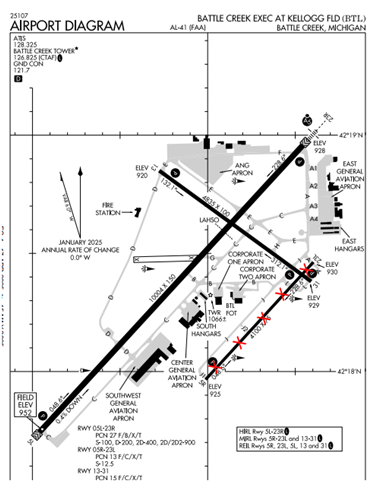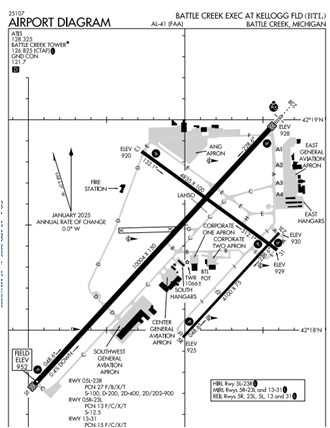 Some airports have the benefit of having parallel runways. While this isn’t the case at all airports, those that do have them sometimes go through the question of “do they really need both runways.” This can be a hard question to answer when considering budgetary concerns related to maintaining extra runways, but there are also safety and operational efficiency considerations that need to be brought into the decision chain.
Some airports have the benefit of having parallel runways. While this isn’t the case at all airports, those that do have them sometimes go through the question of “do they really need both runways.” This can be a hard question to answer when considering budgetary concerns related to maintaining extra runways, but there are also safety and operational efficiency considerations that need to be brought into the decision chain.
Generally, closing a parallel runway at a heavily used training airport significantly undermines safety, reduces training productivity, and increases costs for pilots, as it forces reliance on a single runway, exacerbating congestion and operational challenges.
Here are a few ways this plays out when it happens.
Reduced Safety: A single runway concentrates all traffic—training flights, commercial operations, and general aviation—into one operational space. Student pilots, who require more time for takeoffs, landings, and touch-and-go maneuvers, increase runway occupancy, heightening the risk of runway incursions and near-misses. The lack of segregation between novice and experienced pilots amplifies collision risks in the traffic pattern, especially during peak training hours. Air traffic controllers face heightened workloads, managing diverse aircraft with varying performance characteristics, which can lead to errors or delayed responses in critical situations. Additionally, the absence of a backup runway eliminates operational redundancy, meaning any incident, like a stalled aircraft or maintenance issue, halts all operations, potentially stranding aircraft in unsafe holding patterns or forcing them to outlying airports.
Congestion heightens risks, as student pilots share the runway with diverse aircraft, increasing the chance of runway incursions or mid-air collisions. Novice pilots, still mastering skills, face greater pressure in a crowded traffic pattern, elevating stress and error potential. Without a parallel runway, there’s no buffer for emergencies, amplifying risks during critical training phases.
Reduced Training Productivity: Training airports with only one runway face severe bottlenecks. Repetitive circuits and touch-and-goes, staples of flight training, overwhelm capacity, forcing instructors to limit sessions or schedule during off-peak hours, reducing the number of daily lessons. Students face longer wait times for runway clearance, cutting into actual flight training time. This inefficiency delays skill acquisition and extends the time to earn certifications, frustrating students and instructors alike. A single runway bottlenecks operations, limiting the number of takeoffs, landings, and touch-and-go maneuvers students can perform daily. This restriction forces flight schools to reduce lesson frequency or extend schedules, delaying certifications. Parents, often funding this expensive training, face higher financial burdens as progress stalls, undermining the value of their investment.
Increased Costs for Pilots: Congestion at a single-runway airport often pushes pilots to seek training at alternative airports with parallel runways or lower traffic. This relocation incurs significant costs: additional fuel for transit flights, higher landing fees at busier airports, and potential lodging expenses for students traveling far. For example, flying 50 miles to another airport at 8 gallons per hour and $6 per gallon adds $48 per round trip, excluding time-based instructor fees. These costs accumulate, making flight training less accessible and straining student budgets.
The training provider faces declining productivity as limited runway access restricts flight hours, leading to fewer lessons and delayed student progress. This can erode the provider’s reputation and revenue, as students seek less congested airports. Rising costs from forced relocations to other facilities further strain the provider’s budget and student affordability, potentially reducing enrollment. Safety concerns, like increased collision risks from mixed traffic, also expose the provider to liability and reputational damage.
Closing a parallel runway at a training airport compromises safety by increasing traffic conflicts, hampers productivity by limiting training opportunities, and drives up costs, forcing pilots to seek costly alternatives.
Parents of students training at an airport that has closed [or is considering closing] a parallel runway should be concerned about extended training durations, reduced safety, and a diminished return on their investment in their child’s aviation education. The closure creates a congested environment that disrupts the efficiency and safety of flight training, directly impacting students.
By prioritizing short-term savings over maintaining critical infrastructure, airport management undermines the flight school’s viability and the community’s economic vitality. Students and parents, seeking value and safety, will invest in airports that prioritize their needs, leaving the under-resourced airport and its community with diminished prospects.
Maintaining dual runways where they are available is critical for safe, efficient, and affordable flight training.
Airport management that fails to recognize the adverse effects of closing a parallel runway is not acting in the best interest of a large training provider based at the airport. A major training provider relies on high operational efficiency to serve numerous students, maintain schedules, and ensure safety. By ignoring the increased congestion, heightened safety risks, and reduced training capacity caused by a single runway, management undermines the provider’s ability to operate effectively.
Management’s oversight disregards the provider’s role as a key stakeholder driving airport activity and economic benefits. Prioritizing short-term cost savings over maintaining dual runways jeopardizes the provider’s long-term sustainability, contradicting the airport’s responsibility to support its largest tenants and the broader aviation community’s safety and efficiency.

 A parallel runway at a heavily used training airport significantly enhances safety by segregating traffic, reducing congestion, and minimizing collision risks. Training airports host numerous student pilots practicing takeoffs, landings, and touch-and-go maneuvers, which increase runway occupancy time and airspace complexity. A parallel runway allows simultaneous operations, separating training flights from other traffic, such as commercial or general aviation, thereby reducing the likelihood of conflicts.
A parallel runway at a heavily used training airport significantly enhances safety by segregating traffic, reducing congestion, and minimizing collision risks. Training airports host numerous student pilots practicing takeoffs, landings, and touch-and-go maneuvers, which increase runway occupancy time and airspace complexity. A parallel runway allows simultaneous operations, separating training flights from other traffic, such as commercial or general aviation, thereby reducing the likelihood of conflicts.